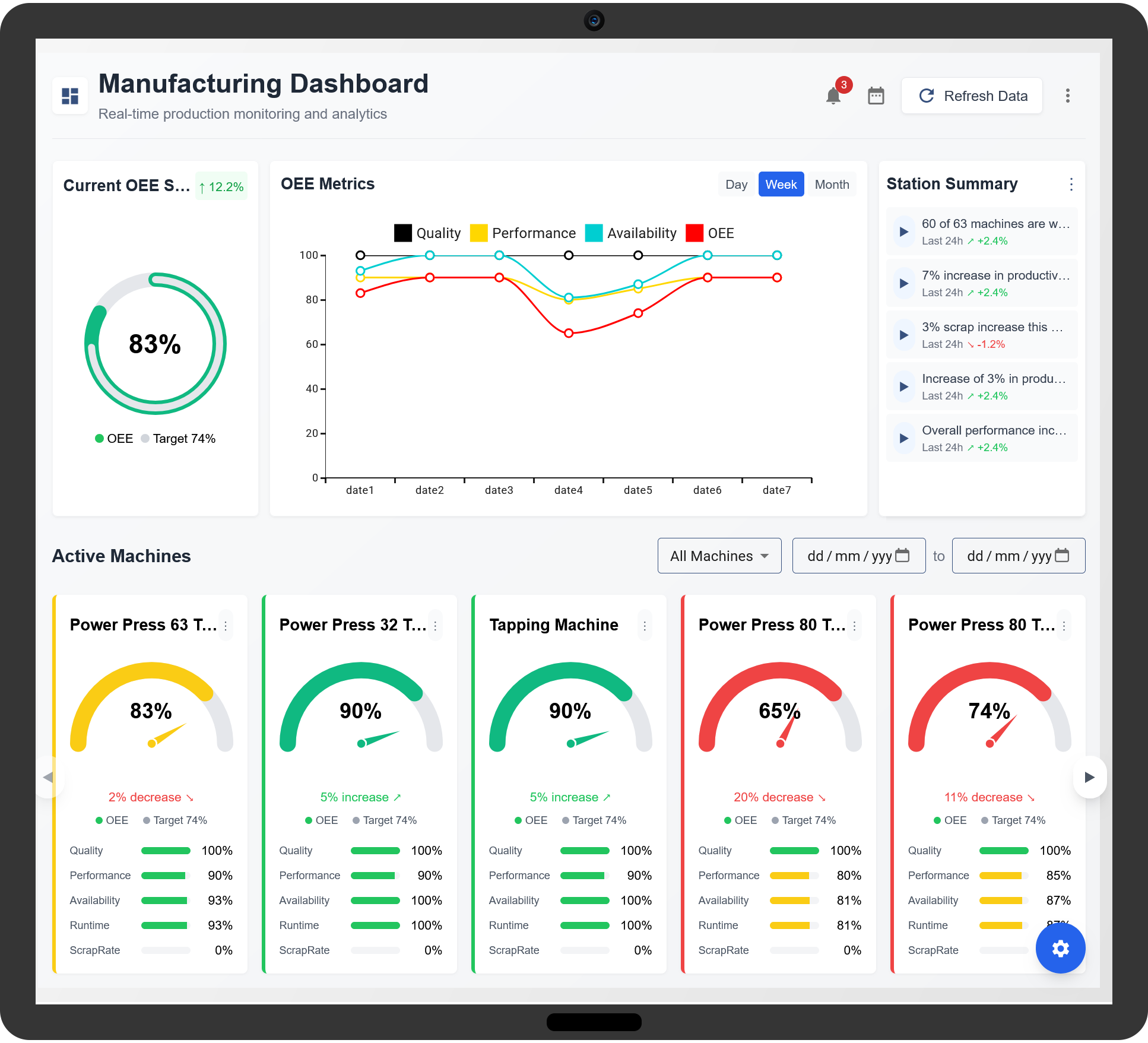Overall Equipment Effectiveness (OEE) is a critical metric in manufacturing that measures the efficiency of equipment by evaluating availability, performance, and quality. Increasing OEE is essential for minimizing downtime, optimizing production, and reducing costs. With the advancement of artificial intelligence (AI) and predictive maintenance, manufacturers can significantly improve OEE by preventing equipment failures, enhancing operational efficiency, and making data-driven decisions.

1. Understanding the Role of AI in OEE Improvement
AI enhances OEE by analyzing machine data, predicting failures, and automating maintenance schedules. Traditional maintenance methods often rely on reactive or scheduled approaches, leading to unnecessary downtime or unexpected breakdowns. AI-driven predictive maintenance helps manufacturers address these challenges by providing real-time insights and optimizing machine performance.
- Real-Time Monitoring: AI collects and analyzes data from sensors to detect anomalies.
- Failure Prediction: Machine learning models predict equipment failures before they occur.
- Automated Decision-Making: AI recommends maintenance actions based on data trends.
- Process Optimization: AI identifies inefficiencies in production workflows.
2. How to Implement AI-Powered Predictive Maintenance
Implementing AI-driven predictive maintenance requires a structured approach to ensure effective data collection, analysis, and action planning.
Step 1: Deploy IoT Sensors
Install IoT sensors on critical machines to collect real-time data, including temperature, vibration, pressure, and energy consumption.
Step 2: Integrate AI Analytics
Use AI-powered analytics tools to process sensor data and detect patterns indicating potential failures.
Step 3: Develop Predictive Models
Train machine learning models to analyze historical data and predict maintenance needs based on patterns.
Step 4: Automate Maintenance Scheduling
Integrate predictive maintenance insights with scheduling systems to ensure timely servicing without disrupting production.
Step 5: Monitor and Optimize
Continuously refine AI models using new data to improve prediction accuracy and enhance OEE.
3. Benefits of AI-Driven Predictive Maintenance
Integrating AI with predictive maintenance offers significant advantages in boosting OEE and overall operational efficiency.
- Reduced Downtime: AI predicts failures before they cause production halts.
- Optimized Maintenance Costs: Eliminates unnecessary maintenance tasks.
- Extended Equipment Lifespan: Prevents excessive wear and tear through timely interventions.
- Improved Production Efficiency: Ensures machines operate at peak performance.
4. AI-Driven Root Cause Analysis
AI not only predicts failures but also helps identify the root causes of recurring issues. By analyzing large volumes of machine data, AI can pinpoint the factors leading to inefficiencies.
- Pattern Recognition: Identifies trends linked to equipment failures.
- Cause-and-Effect Analysis: Determines whether failures are due to external factors such as environmental conditions or internal factors such as wear.
- Continuous Learning: AI improves its analysis over time as it processes more data.
5. AI-Powered OEE Dashboards
AI-driven dashboards provide real-time visibility into equipment performance, helping managers make informed decisions.
- Live OEE Metrics: Displays availability, performance, and quality scores.
- Predictive Alerts: Notifies teams of potential issues before they impact production.
- Customizable Reports: Generates insights tailored to specific operational needs.
6. Overcoming Challenges in AI-Driven OEE Enhancement
While AI offers transformative benefits, manufacturers must address key challenges for successful implementation.
- Data Quality: Ensure accurate and consistent data collection.
- System Integration: Seamlessly integrate AI with existing manufacturing systems.
- Workforce Training: Educate teams on leveraging AI-driven insights effectively.
7. The Future of AI in OEE Optimization
As AI technology advances, its role in OEE improvement will continue to expand, leading to smarter, more efficient manufacturing operations.
- Self-Learning Systems: AI models that adapt to new operational conditions.
- AI-Driven Production Optimization: Enhancing not only maintenance but overall workflow efficiency.
- Autonomous Maintenance: AI-powered robots performing routine maintenance tasks.
By embracing AI and predictive maintenance, manufacturers can achieve higher OEE, reduce costs, and enhance operational efficiency, ensuring long-term competitiveness in the industry.
Increase OEE with AI and predictive maintenance
How does AI improve OEE in manufacturing?
AI enhances OEE by analyzing real-time data, predicting failures, and optimizing maintenance schedules to reduce downtime and improve efficiency.
What role does predictive maintenance play in OEE improvement?
Predictive maintenance reduces breakdowns by analyzing equipment conditions and forecasting potential failures before they occur.
How can AI reduce unplanned downtime?
AI identifies patterns in machine performance, allowing proactive maintenance actions that prevent sudden equipment failures.
What are the key AI-driven analytics for OEE optimization?
AI-driven analytics include real-time monitoring, predictive failure detection, anomaly detection, and root cause analysis to enhance OEE.
How does AI help in predictive failure detection?
AI detects early warning signs of equipment failure, allowing maintenance teams to address issues before they impact production.
What is the impact of real-time monitoring on OEE?
Real-time monitoring ensures continuous visibility into machine performance, helping to quickly identify inefficiencies and minimize production losses.
How does machine learning optimize maintenance schedules?
Machine learning analyzes past performance data to recommend optimal maintenance intervals, reducing unnecessary downtime.
What is anomaly detection, and how does it improve OEE?
Anomaly detection uses AI to identify deviations in machine performance, enabling early intervention before critical failures.
How can AI optimize production planning for better OEE?
AI analyzes demand, machine availability, and workforce capacity to create efficient production schedules that minimize downtime.
What role does AI-based automation play in reducing equipment failures?
AI automates routine checks and alerts operators to potential failures, reducing manual intervention and improving reliability.
How does AI-driven root cause analysis enhance OEE?
AI analyzes failure patterns to determine root causes, enabling long-term improvements in equipment reliability.
What are digital twins, and how do they impact OEE?
Digital twins replicate physical equipment in a virtual environment, allowing predictive maintenance and performance optimization.
How can AI-based predictive analytics improve maintenance efficiency?
AI uses data-driven insights to schedule maintenance only when needed, reducing unnecessary maintenance and maximizing uptime.
What is the connection between AI, predictive maintenance, and quality improvement?
AI-driven predictive maintenance prevents defects by ensuring machines operate at optimal conditions, improving product quality.
How does AI-driven OEE tracking help in continuous improvement?
AI continuously analyzes OEE metrics, identifies areas for improvement, and suggests data-driven strategies to enhance efficiency.